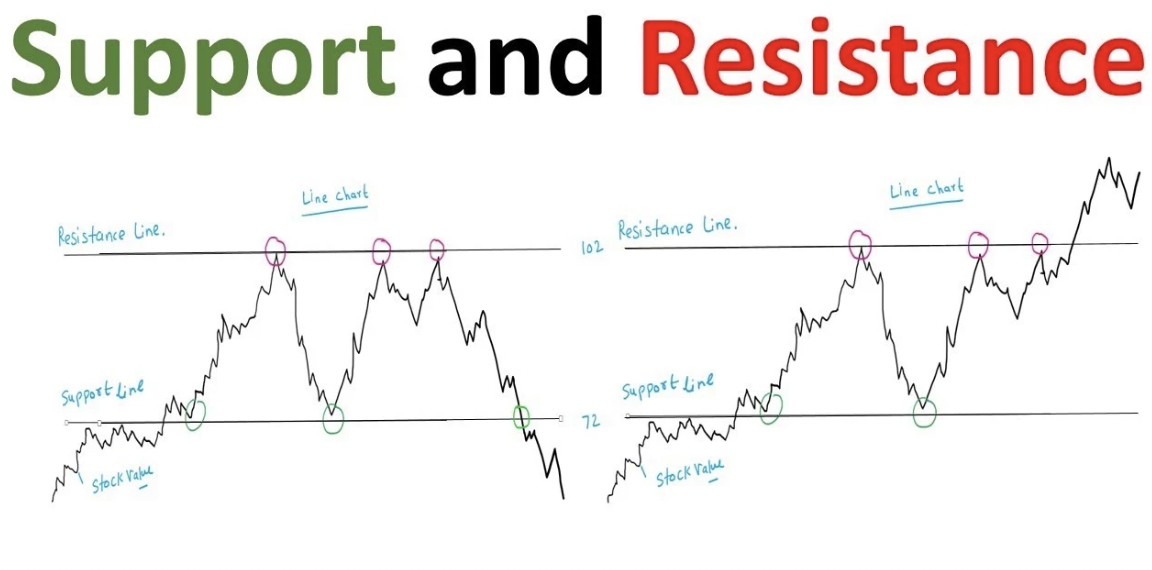
Charlie Brooks
Apr 18, 2022 17:25

As equities markets proceeded to reach new highs, a few of them developed Parabolic Arc Chart Patterns.
When these Parabolic Arc patterns began to descend from their peaks due to the Coronavirus, they began to generate sell signals. We will explain how Parabolic Arc patterns function and how they are traded in this section.
The parabolic chart is one of the most potent uptrend patterns that a stock chart may display. This pattern often occurs during a period of buildup, and it rises the highest and fastest in a short time. This pattern has the potential to provide a significant profit in the shortest amount of time.
The parabolic arc pattern is named after the parabola since the rising curving line used to draw this pattern from the candlestick price movement resembles a parabola. This pattern may last for weeks, if not months. The pattern of price activity that generates the parabolic curve resembles a stairway. For traders who learn how to trade it correctly, the pattern may provide incredible profits in the shortest amount of time.
As a general rule, the trading opportunity presented by parabolic curve patterns occurs at or around the conclusion of a significant market gain. The pattern is often formed due to many base formation breakdowns. This powerful price pattern may reward a trend trader with spectacularly large profits in a short period.
However, at the formation's conclusion, the price often makes the most significant move straight into the severely overbought condition and then abruptly drops much quicker than it ascended.
When prices increase sharply due to impulsive purchasing and excessive speculation, parabolic arc chart patterns form. Although Parabolic Arc patterns are uncommon, they are very dependable and occur during gigantic bull periods. These patterns tend to trend progressively upward, with higher highs and lower lows in the early stages, but maybe volatile during the fatigue and reversal.
The parabolic arc is a pattern of reversal with a relatively predictable ending. Although they are foreseeable, they are rather difficult to trade due to the positive market attitude and the difficulty of trading point reversals. Most parabolic arc patterns exhibit a considerable correction of between 62 and 79% of their price gain (from the top).
The parabolic arc pattern was first spotted over 50 years ago and was incorrectly referred to as a parabolic trend. Observing a parabolic arc pattern was not frequent at the time.
This pattern gained popularity among traders as market participation increased. Traders may utilize the parabolic arc pattern to indicate a rapidly progressing trend. As time passes, the steepness of the curve rises.
This fast price surge is primarily due to panic purchasing, which drives prices to unsustainable heights before the inevitable abrupt drop. Rapid collapse is a hallmark of these trends when prices go to the right side of the trend line, forming a parabolic curve.
The Pattern is simple to identify but difficult to trade due to the pattern's high volatility.
Most Patterns retrace their steps to within 62–78 percent of their initial height, and the initial objective is a 50% retracement.
Avoid overstaying your welcome in your transactions.
Avoid purchasing "Parabolic Arc" patterns (following retracements) since you seldom profit from them.
Determine where/when it will begin reversing.
Expect the price to remain far below the Parabolic Arc highs for an extended period.
Prices rise vertically in Parabolic Arc patterns until the acceleration comes to a halt and reverses. Prices begin to make lower lows and may seek to reclaim the peak. Create a channel linking the pattern's top and bottom. At the second unsuccessful effort to test the high or at the collapse of the channel trend line linking the big swings, enter a "short" trade.
Measure the increase between the pattern's base and peak. Most Parabolic Arc patterns revert to the 62–79 percent of their initial climb.
Protect the trade by putting a few ticks above the Parabolic Arc's high.
The Parabolic Curve Pattern is a very effective chart pattern, first and foremost, since the price soared too high and quickly. This strong ascent is unsustainable, and anytime this chart pattern happens, a price reversal is predicted. Second, the time necessary to create the parabolic curve demands considerable patience. Compared to other chart patterns such as the head and shoulders or cup and handle, the parabolic curve pattern might take an extended pattern time to emerge. Thus, traders must exercise extreme patience for the parabolic curve pattern to emerge and be prepared for the breakout.
The pattern's psychology is related to impulsive purchasing and strong speculation. As the stock rushes to new highs, market players grow more enthusiastic, sometimes overlooking price and risk/reward considerations. This powerful price pattern can provide very substantial profits in a very short period.
Often, stocks will appreciate towards the start of a strong rally or near the conclusion of a major bull run. Trading ranges or technical bottoms in the short-to-medium term often result in technical breakouts and new record highs. Technical base patterns often repeat themselves numerous times while the underlying stock or market moves too much higher and to unsustainable heights.

These patterns are more prevalent in strong growth and momentum stocks. These stocks are market leaders due to the introduction of novel goods, technologies, business methods, or paradigms.
The price action pattern becomes a parabolic shape, like a staircase. The pattern may span weeks, months, or even quarters, depending on the market's general state. After a straight-up rise, the danger zone comes at the formation's conclusion, which pushes the situation to severely overbought levels. The more technical base breakouts occur before the extreme situation, the greater the risk of a faster and steeper price decline when the trend reverses direction.
Patterns of the Parabolic Arc include both panic purchasing and panic selling situations. When a stock breaks out and begins to soar, investors often believe its upward cycle will never stop and develop confidence based on frenzy. As the stock chart adopts an exponential curve form, this misjudgment instills blind trust in investors. The price continues to increase without pausing and/or with a succession of upward gaps while it is in the rising parabolic arc condition. Each year, the stock price may double, treble, or quadruple as a result of this process.
In their final stage, parabolic arcs climb upwards as a result of panic purchasing (climactic purchase) in the absence of sellers based on erroneous expectations/news/events. The majority of this climactic purchase is motivated by momentum and fear of being left behind by professional traders. Finally, reality kicks in with a terrible incident or piece of unpleasant news, which drives buyers away, resulting in Panic Selling. As the early buyer's profit, the prices revert significantly with wide fluctuations. The traders who purchased at the top began to worry as well. Thus, in the majority of circumstances, Parabolic Arcs are excellent trades once they hit their panic buying point.
You may be curious about the appearance of the parabolic arc pattern. To put it simply, the parabolic curve pattern is a quickly climbing trend that a curved trend line may match. A parabolic curve pattern is a curved trend line that resembles an arc or an ellipse. It is more akin to a distorted parabola, and a secret computation determines the curve's ultimate shape. Thus, it resembles a skewed parabola, but the form of the curve is determined by how the trader fits the line.
Specific trading platforms have automated tools that may be used to charts to automatically create parabolic arcs wherever they appear. The photos below demonstrate how the pattern appears:

The parabolic arc stock chart pattern is one of the most powerful uptrend patterns a stock may have. The term "parabolic curve" originates with the parabola. This is because the downward-curving trend line utilized to determine the intensity of this pattern from this assist action is shaped like a parabola. Such strong price patterns may reward a trend trader with spectacularly big profits in a short period of time.
The pattern of price activity that generates the parabolic curve resembles a stair rail. This pattern may last for weeks and, in extreme instances, months. The downside occurs at the formation's conclusion, after the strongest move straight up to an extremely overbought level.
The rapidly rising price movement often comes to an abrupt halt in a price crash that falls faster than it ascended.
These patterns often manifest themselves in growth stocks after the introduction of new goods, a new corporate structure, new technology, or new leadership. Stocks that exhibit this level of volatility are essentially market leaders.
The parabolic arc pattern develops as a consequence of fast price movement in a stock that attracts a large number of investors. While the stock is rising upward, traders and analysts discuss it, which increases the company's attraction to those who have not yet purchased it. Fear of missing out (FOMO) motivates traders and investors to enter, increasing the stock price. Without more buyers to maintain the price increase, the stock plummets precipitously.
Often, the parabolic arc pattern manifests itself towards the start or finish of a bull market surge. Typically, the pattern results in brief pullbacks in the shape of a narrow price range that swiftly expands to new highs. As it climbs higher, it repeats this range pattern numerous times.
There are several reasons to trade this pattern. To begin, the movie is often swift and may result in quick money. As a result, it's prudent to watch movements that develop rapidly and to enter and exit promptly before they expire.
Additionally, the pattern might assist you in identifying accelerating trends inside a larger upswing. Because the pattern indicates certain entrance and exit positions, you may profit from it if you understand how to play it.
It is suitable for tracking very fast-moving trends, most notably when high panic purchases force prices to skyrocket.
You may use it to identify patterns that are accelerating.
It identifies precise entry and exit points for traders depending on how the parabolic pattern is traded.
This parabolic curve is most effective when used in conjunction with price or derivative leverage.
As a buyer, if you enter late, after prices have risen so rapidly that the curve is almost vertical, you must be aware of the inevitable price collapse that will follow.
It is often more difficult to decipher this pattern during the early stages of trend formation.
The Parabolic Curve Pattern Strategy is particularly prevalent during periods of rapid economic change. Traders are most aware of themselves when they are ahead of an event, and the time period before a large-scale event is one of the most visible methods for the public to detect a more parabolic arc.
Although the previously described pattern is not identical to the cubicle scenario, you can see how a strong price surge resulted in the parabolic pattern.
A critical point to remember is that it takes time for the pattern to establish. In the majority of cases, the parabolic procedure will occur at the point of departure from this design. Traders will rapidly recognize a certain pattern and do business according to it.
Immediately after a break-out, the sell price action may be quite rapid as traders begin to unwind their positions. Thus, it is critical to conduct trade at the proper moment.
This pattern is traded in isolation from any other signal, and it is a self-contained indication. Immediately when the price action breaks to the right of the trend line, this is an excellent time to enter a short trade.
To be considered a true parabolic curve, the trend line that generates the parabolic curve must contact at least two points. However, to construct a proper trend line plot, the trend line should intersect three starting low points.
Investors may trade the parabolic arc pattern in two ways. These are the long and short trades, respectively.
Long Trades
At the conclusion of long uptrends, stocks go parabolic. This pattern manifests itself when panic purchasing occurs, and prices approach a vertical point. This is related to FOMO (Fear Of Missing Out) since the public wants to profit and purchase at more excellent prices.
Short Trade
This specific trading position is far safer to perform and provides greater certainty. Parabolic curves almost always reach the point of price decline. Be cautious if (or, more likely, when) the parabolic collapse occurs... Prices may revert to the level at which the parabolic climb started.
I trade Parabolic Arc patterns largely on their descent since I see them as reversal patterns.

The parabolic pattern on its ascent may become apparent throughout its construction's early to mid-stages. It may indicate the presence of a Parabolic Arc at various ranges on the rise and may be traded in conjunction with range/channel breakouts. Trading rising markets include dread since traders have no idea where or when the market may reverse, as no other data points are accessible. Trading rising Parabolic Arc patterns requires traders to use considerable care.
Once panic purchasing develops a vertical trend, it becomes a climax or exhaustion trade. This is when the Parabolic Arc gets more intriguing to me as I begin to seek failures and indicators of a trend reversal. I've developed an auto-detection algorithm/indicator for Parabolic Arc patterns that I use to indicate the risk of failure/trade levels and goals. I examine almost every day for more ideas and chances with Parabolic Arcs. Additionally, the reversal in the Parabolic Arc pattern occurs significantly quicker than the pattern's climb (in most cases).
The Parabolic Arc is a reversal pattern with a fairly foreseeable conclusion. While these patterns are predictable, they are adamant about trading when the market is optimistic, and they may be rather challenging to change due to their acute nature. Most Parabolic Arc patterns have an important link with the price spike, ranging from 62% to 79%.
To summarize, the parabolic arc pattern may be a profitable trading method. The conventional wisdom in the trading sector is that those who cannot maintain excessive price increases. The Parabolic Curve Pattern assists us in recognizing this rule, and if we leave our emotions aside, detecting the Parabolic Curve Pattern is really relatively simple.
Bear in mind that price movement may be violent, and trading this chart pattern is not for the faint of heart. To be successful in trading this pattern, traders must practice sound money management and have self-confidence in their decision-making.

Apr 18, 2022 17:17

Apr 18, 2022 17:39